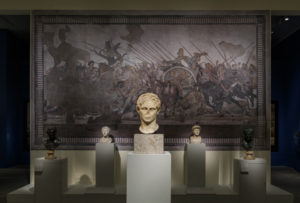History is highlights for most of us. We tend to skip from the story of Alexander the Great straight to that of Cleopatra and Marc Antony. But between those cinematic personalities was a fascinating period of 300 years when Alexander’s empire was transformed into a gigantic advertisement for Greek culture.

This was the Hellenistic age. Think of Ionic columns and classical pediments adorning cities from modern-day Turkey to Pakistan. Think of these people speaking Greek, worshipping Zeus and Athena and enjoying plays by Euripides and Aeschylus.
Perhaps this story has never made a great movie, but it makes great art history. And now, coming to a museum near you is “Pergamon and the Hellenistic Kingdoms of the Ancient World,” a stunning show at the Metropolitan Museum of Art that brings the ancient world to life with statues of gods and kings, images of a lost city, reliefs of thrilling battles, gold jewelry, coins, and engraved gemstones.
The star of the show is the ancient city of Pergamon, now known as Bergama, in present-day Turkey. A citadel perched on a mountain ridge above the Caikos River valley, Pergamon did a spectacular imitation of fifth century B.C. Athens in second century B.C. Asia Minor. Pergamon’s Attalid rulers transformed a simple garrison into a showplace of Greek culture with royal palaces, a library of more than 200,000 scrolls, a museum, a temple to Dionysos, a theater, gymnasiums, and, the crowning jewel – a magnificent altar facing the sea.
Paintings, panoramic videos of then and now, and a gleaming white model give visitors an idea of what this opulent pile looked like. The focus is on the famous altar, a mix of Oriental splendor and Greek humanism that looks like a cross between a giant parade reviewing stand and a wedding cake.

One of the show’s standout images is the 11-foot-wide painting of the acropolis by Freidrich von Thiersch, an architect from an 1881 German excavation. He enlivened his image with hundreds of tiny figures, including a long procession of people and animals ascending to the sacrificial altar where a chimney sends up the smoke of burnt offerings.
The 1995 model — one-twentieth the size of the original – gives you a better idea of the altar’s famous reliefs. On the outside was the so-called Gigantomachy, depicting a violent battle between the Greek Olympian gods and the terrifying giants of the earth. At stake is the order of the universe, and fortunately the gods are clearly overwhelming the clumsy giants. Everything is wild movement and fluttering drapery with some relief figures actually spilling out of the wall onto the altar steps.
A few frieze fragments help convey the flavor of the fantastic imagery, including a serpent’s head that was actually the foot of one of the bizarre giants.
Unlike the Gigantomachy, the 12-piece Telephos Frieze on the altar’s inside walls is a sequenced narrative. It tells the story of the demi-god hero Telephos, a descendant of Hercules and an Attalid princess. One panel illustrates the scene where Hercules finds the abandoned infant Telephos suckling on a lioness.
This is a show with surprises of scale. The signature image – an evocative fragment of a young man’s head cut off just below the eyes – doesn’t prepare you for its colossal size. The youth’s dimpled chin is massive, his neck the width of a tree trunk. It was found on the upper terrace of the Pergamon gymnasium and is thought to be a head of Alexander.

The first gallery of the exhibit, devoted to the “Age of Alexander.”
Another titanic presence is the towering statue of Athena Parthenos. It’s a smaller copy of the one that stands in the Athenian Acropolis but at 13 feet, it towers above all else here.
Hellenistic sculpture could be baroque in its frenzied movement, but also excelled at a new sculptural realism. One of the show’s masterpieces is “Dying Gaul,” a larger than life figure of a wounded warrior who struggles to support himself on one shaky arm. Although made to celebrate a victory by Pergamon over the Celtic tribes, it shows great empathy for the enemy.
History catches up with the Hellenistic age at exhibit’s end where a set of reliefs show the naval battle of Actium. Here, the ships of Octavian (the future Augustus Caesar) defeated the Egyptian fleet of Cleopatra and Marc Antony. The playfulness of the little figures scampering about the decks of the galley ships enlivens the art, even as it belies the gravity of the event, which ushered in the era of Imperial Rome.
As for Pergamon, its flowering was relatively brief. The last Attalid ruler died in 133 B.C. The city enjoyed prominence for a while as the Roman capital of Asia, but ultimately people abandoned its craggy heights for the more comfortable valley below. The opulent citadel was left to crumble until the 1870s when the first German archaeologists arrived.

